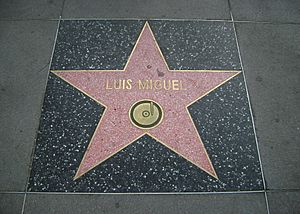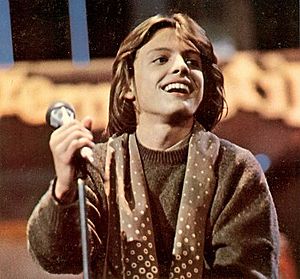Luis Miguel facts for kids
Luis Miguel Gallego Basteri (born April 19, 1970) is a famous Mexican singer and music producer. He was born in Puerto Rico. His mother was Italian, and his father was Spanish. People often call him El Sol de Mexico, which means "The Sun of Mexico." This nickname came from his mother, who used to call him "Mi sol" (My sun).
Luis Miguel has sung in many different music styles. These include pop songs, ballads, boleros, and mariachi music. He is known for being the only Latin singer of his time who did not start singing in English during the "Latin Explosion" of the 1990s. Even though he only recorded in Spanish, Luis Miguel was the top-selling Latin artist in the 1990s. He helped make the bolero music style popular again.
He has sold about 60 million records around the world. This makes him one of the best-selling Latin music artists ever. His exciting live shows and personal life have kept him popular throughout his career. His journey in music began in Mexico in 1981.
When he was just 14, Luis Miguel won his first Grammy Award. He won it for his song "Me Gustas Tal Como Eres" which he sang with Sheena Easton. This made him one of the youngest artists to ever win a Grammy. In 1991, his album Romance was recognized as one of the best-selling Latin albums of all time.
He was the first Latin artist to receive two platinum awards in the United States for Spanish-language albums. These were for Romance and Segundo Romance. Segundo Romance also earned him 35 platinum records across Central and South America. Billboard magazine also recognizes him for having the most songs in the top 10 on their Hot Latin Songs chart.
His album Cómplices, released in 2008, reached number 10 on the main Billboard 200 chart. His most recent album, ¡México Por Siempre!, came out in 2017. It became his second number 1 album on the Billboard Regional Mexican Albums chart and earned double-platinum status.
Luis Miguel is also famous for his amazing live concerts that earn a lot of money. He is the highest-earning Latin artist from tours since 1990. He has made over $633.1 million and had 6.3 million people attend his shows. His Luis Miguel Tour 2023–24 visited 20 countries in North America, South America, and Europe. He performed 194 shows in a year and a half. This made it the highest-earning tour ever by a Latin artist.
He also holds the record for the most consecutive shows at the National Auditorium in Mexico City, with 30 concerts in a row. He also has the record for the most total concerts at that same venue, with 258 shows. As of October 2020, Luis Miguel is ranked number two on Billboard's list of the Greatest Latin Artists of All-Time.
Contents
- Early Life and First Steps in Music
- Music Career Highlights
- Early Success and New Styles (1984–1987)
- Becoming a Superstar (1988–1990)
- Romance and Global Recognition (1991–1993)
- Continued Success and New Albums (1994–1999)
- New Music and Awards (2003–2004)
- Greatest Hits and Christmas Album (2005)
- Recent Albums and Tours (2008–2018)
- Television Series and Latest Album (2017–2018)
- Personal Life
- Artistic Style and Public Image
- Music Albums
- Concert Tours
- Awards and Nominations
- Film and TV Appearances
- See also
Early Life and First Steps in Music
Luis Miguel was born in San Juan, Puerto Rico. His parents were Luisito Rey and Marcella Basteri. When he was a child, his father, who was also his manager, encouraged him to study the performances of Elvis Presley.
In 1982, Luis Miguel released his first album, Un Sol. He was only 11 years old at the time. This album earned him his first gold record. Two years later, he started touring in Latin American countries like Colombia, Venezuela, Chile, and Argentina. The song "1+1=Dos Enamorados" from Un Sol became a big hit.
Music Career Highlights
Early Success and New Styles (1984–1987)
In 1984, Luis Miguel changed his music style to Spanish pop rock. This happened with his album Palabra de Honor. In 1985, at age 15, he took part in the Sanremo Music Festival in Italy. He won second place with his song "Noi Ragazzi Di Oggi". That same year, he won an award at the Viña del Mar International Song Festival. This was for his duet "Me Gustas Tal Como Eres" with Scottish singer Sheena Easton. He also appeared in movies like Ya Nunca Más (1984) and Fiebre de amor (1985).
In 1986, he took a short break from music. His relationship with his father became difficult. After signing with Warner Records in 1987, he decided to work with Juan Carlos Calderón. Luis Miguel's album Soy Como Quiero Ser, released in May 1987, sold over 2.5 million copies. This album included Spanish versions of popular English songs.
Becoming a Superstar (1988–1990)
On November 25, 1988, Luis Miguel released his album Busca una Mujer. The first song, "La Incondicional", became a top-ten hit across Latin America in 1989. Its music video was a surprise to many fans because he had cut his long hair. This moment showed his change from a child star to an adult superstar. By the end of 1989, another song, "Fría Como el Viento", reached number 1 on the Hot Latin Tracks chart. He also had a top-ten hit with "Separados" in early 1990.
In 1990, he continued his successful move to being an adult performer with the album 20 Años. This led to many sold-out shows in Mexico and other parts of the world. 20 Años sold 600,000 copies in its first week. It produced three hit songs: "Tengo Todo Excepto A Ti", "Entrégate", and "Amante del amor". The first two reached number 1 on Billboard's Hot Latin Tracks in 1990.
Romance and Global Recognition (1991–1993)

In 1991, Luis Miguel's career grew even more with the album Romance. This album featured romantic boleros, many from the 1950s. He is credited with making bolero music popular again for modern listeners. Romance became his most successful album, selling 7 million copies worldwide.
In 1993, Luis Miguel released his fifth studio album, Aries. This album won him a Grammy Award for Best Latin Pop Album that year. In the same year, Frank Sinatra invited Luis Miguel to sing on his album Duets II. He also performed live in a TV special honoring Sinatra's 80th birthday, alongside stars like Stevie Wonder and Natalie Cole.
Continued Success and New Albums (1994–1999)
In 1994, he released Segundo Romance, a follow-up to Romance. This album showed him as a strong pop singer who could master classic Latin songs. Segundo Romance earned him another Grammy Award and platinum status in the United States.
In 1996, Luis Miguel received a star on the Hollywood Walk of Fame. He was the youngest male singer at that time to get a star. Soon after, he released Nada Es Igual, a pop album. It included "Sueña", the main song for Disney's movie The Hunchback of Notre Dame.
In 1997, Luis Miguel released his third bolero album, Romances, which sold over 5 million copies. The song "Por Debajo de la Mesa" quickly reached number one on the Billboard Hot Latin Songs chart. At the 40th Annual Grammy Awards in 1998, Luis Miguel won Best Latin Pop Performance. He also received awards from Billboard and the World Music Awards that year.
In 1999, Luis Miguel released Amarte Es un Placer. In 2000, this album won him two Latin Grammys for Album of the Year and Pop Album of the Year. The song "O Tú, O Ninguna" from this album became number 1 on the Billboard Hot Latin Tracks for eight weeks. After this success, Luis Miguel released Mis Romances in 2001, his fourth bolero album. This album sold over two million copies worldwide. He then went on the Mis Romances Tour across the U.S., Europe, and Latin America.
New Music and Awards (2003–2004)
In 2003, Luis Miguel released 33, his first pop album in over four years. The title referred to his age. This album, with its ballads and upbeat songs, reached number 1 on Billboard's Latin Charts. It earned him two Billboard Awards and nominations for Grammy and Latin Grammy awards. On the 33 Tour, Luis Miguel performed in large venues across the U.S. and Latin America. His album 33 sold 2.5 million copies in Chile.
That same year, Prince Felipe of Spain gave him a special award. This was for being the best-selling foreign artist in Spain's history. Luis Miguel also received a "Premio Lo Nuestro a la Excelencia" (Award for Excellence) in 2003. This was a lifetime achievement award for his amazing career, and he was the youngest artist to receive it at age 33.
In 2004, Luis Miguel released Mexico En La Piel. This album was a collection of traditional Mexican mariachi songs. It sold five million copies worldwide. For this album, he received a diamond award and won a Latin Grammy Award in 2005. He also won a Grammy Award for Best Mexican/Mexican-American Album. He started his Mexico En La Piel Tour in 2005. In 2006, Luis Miguel performed thirty shows at the National Auditorium in Mexico City. The tour had 123 dates and started in September 2005 in Mexico. It then went to Argentina, Chile, and Uruguay. The Mexico En La Piel Tour won the Billboard "Tour of the Year" award.
Greatest Hits and Christmas Album (2005)
In 2005, Luis Miguel released Grandes Éxitos, his first greatest hits album. It included his most popular songs and two new ones: "Misterios Del Amor" and "Si Te Perdiera". That same year, he released a Christmas album called Navidades. This album featured many classic Christmas songs in Spanish. It reached number one on Billboard's Top Latin Albums chart in its first week. The album released two songs: "Santa Claus Llegó A La Ciudad" ("Santa Claus Is Comin' to Town") and "Mi Humilde Oración".
Recent Albums and Tours (2008–2018)
On May 6, 2008, Luis Miguel released Cómplices. He produced it, and Spanish composer Manuel Alejandro wrote the songs. It sold almost 350,000 copies in the first 24 hours. The first song, "Si Tú Te Atreves", came out on April 7, 2008. The second song was "Te Desean". Complices made history by reaching number 10 on the Billboard Top 200 chart. This was the highest position a Latin artist had ever reached with an all-Spanish album. It also reached number 1 on the Billboard Top Latin Albums chart. This made him the Latin artist with the most number 1 albums on that chart, with a total of 9. His Complices Tour began in Seattle, Washington, on September 3, 2008.
Luis Miguel released his self-titled album on September 14, 2010. Its first song, "Labios de Miel", was a smooth Latin pop song. The tour for this album started on November 4, 2010, in Lima, Peru. It covered the United States, South America, Mexico, and Spain. On February 22, 2012, he sang at the Viña del Mar International Song Festival. He became the most expensive artist in the festival's history for his performance. Luis Miguel also performed at the Curaçao North Sea Jazz Festival on August 31, 2013. In August 2014, a song called "Déjà Vu" was shared online before its official release.
Television Series and Latest Album (2017–2018)
On May 4, 2017, Telemundo announced they would broadcast an "officially authorized TV series" about Luis Miguel's life in 2018. Netflix also announced they would stream the series in Latin America and Spain.
On his official Facebook page, Luis Miguel announced his new song "La Fiesta del Mariachi" would be released on October 27, 2017. On November 24, the full album, titled ¡México Por Siempre!, was released. It has 14 songs of traditional Mexican music. The tour began in February 2018 at the National Auditorium in Mexico City and ended in September 2019 in Las Vegas.
On April 22, 2018, Netflix and Telemundo began airing the series Luis Miguel. This show revealed many known and unknown parts of the singer's life. It also brought back fun memories for viewers, like a scene that looked just like his old Sabritas potato chip ad. Two more seasons of the show were released in 2020 and 2021.
Personal Life
Luis Miguel's father was a Spanish singer, songwriter, and guitarist named Luis Gallego Sánchez, known as "Luisito Rey". His mother was an Italian actress, Marcella Basteri. His father was from Cádiz, Spain, and his mother was from the Province of Massa-Carrara, Italy. He was named Luis Miguel to honor the Spanish bullfighter Luis Miguel Dominguín. Luis Miguel has two younger brothers.
His actual birth date is April 18, but he celebrates his birthday on April 19. This is because that was the day his father registered his birth in Puerto Rico.
Because he became famous at a young age, Luis Miguel had a challenging childhood. He had a difficult relationship with his father, who was also his manager. His father was very strict and demanding during rehearsals. In 1986, Luis Miguel's mother disappeared, and her location is still unknown. In the late 1980s, Luis Miguel stopped working with his father. His father passed away on December 9, 1992, in Barcelona, Spain.
Luis Miguel is known for his love of fine food and for being a self-taught wine expert. He even released his own wine called "Único. Luis Miguel", which is a Cabernet Sauvignon. He speaks Spanish, English, Italian, and Portuguese. Luis Miguel has three children. One was born in June 1989, from his relationship with Stephanie Salas. Two more were born in January 2007 and December 2008, both from his relationship with actress Aracely Arámbula. His relationships are often talked about in Latin media.
He has said about his faith, "I am Catholic because I was born in a Catholic family. I believe in God, I visit church whenever I rarely have the chance due to my work commitments." He prefers not to talk about politics, saying that an artist should focus on their songs. In April 2010, he was briefly in the hospital in Los Angeles. The reason for his hospital stay was not shared. On May 2, 2017, Luis Miguel went to the U.S. Marshals because of a case with his former manager. He was ordered to pay his manager over one million dollars in July 2016. He signed a paper promising to pay and was released soon after.
Artistic Style and Public Image
Luis Miguel rarely gives interviews or goes to award shows. He is always with a security team and uses several cars to avoid photographers and reporters. He has said, "I stay sane by keeping my distance."

Luis Miguel is seen as one of the best male pop singers in the world today. His voice can reach many different notes. In a career that has lasted almost forty years, he has become the most important male singer from Latin America. He has successfully performed pop music, bolero, mariachi, and romantic ballads. In the late 1980s, Luis Miguel changed from a child star to a well-known international singer. Since then, he has become one of the most respected and popular Latin American artists ever. He is also called a "crooner" because of his wide vocal range and performances. Other artists and critics around the world have praised his singing. Producer Gustavo Santaolalla called him "one of the greatest singers of all time." He also said, "Luis Miguel is not just a singer, he's an artist."
Frank Sinatra personally asked Luis Miguel to sing a duet on his album Duets II. The press and media have often called Luis Miguel the "Latin Frank Sinatra." His music has reached places like Asia and Africa. It was even reported that when dictator Saddam Hussein was captured, he had Luis Miguel's album Segundo Romance with him.
His total wealth is thought to be around $180 million.
Major Achievements
- At age 14, Luis Miguel won a Grammy Award for his duet "Me Gustas Tal Como Eres" with Sheena Easton.
- In 1991, the RIAA recognized him for the high sales of his albums Romance and Segundo Romance.
- He was the only Latin artist to perform at the "Sinatra: 80 Years My Way" show. He performed alongside other pop stars like Bruce Springsteen, Natalie Cole, and Bob Dylan.
- His 1997 album Romances was the first Spanish-language album to debut at number 14 on the Billboard Top 200 chart.
- Warner Music Group recognized Luis Miguel as the best-selling artist in Chile's history, with over 2.5 million records sold.
- In 2003, Prince Felipe of Spain gave him a special award for being the best-selling foreign artist in Spain.
- In 2008, Luis Miguel's album Navidades was the first Christmas album to be nominated for a Grammy in the Pop category.
- His album Cómplices broke records in Mexico, selling over 320,000 copies on its first day. Just three days after its release, it earned Quadruple Platinum in Mexico, Platinum in Argentina, and gold records in Chile and the United States.
- His tours have been very successful, including the Mexico En La Piel Tour (2005–2007) which had 129 concerts and earned around $95 million.
- In 2006, during the Mexico En La Piel Tour, he performed 30 sold-out concerts in a row at the National Auditorium in Mexico. He was given the "Estela de Plata" award.
- His Luis Miguel Tour was ranked among the highest-earning tours in North America in 2011.
Awards and Recognitions
|
|
Music Albums
- Un sol (1982)
- Directo al corazón (1982)
- Decídete (1983)
- Ya nunca más (1983)
- También es Rock (1984)
- Palabra de Honor (1984)
- Fiebre de amor (1985)
- Soy como quiero ser (1987)
- Busca Una Mujer (1988)
- 20 Años (1990)
- Romance (1991)
- Aries (1993)
- Segundo Romance (1994)
- Nada Es Igual (1996)
- Romances (1997)
- Amarte Es Un Placer (1999)
- Mis Romances (2001)
- 33 (2003)
- México En La Piel (2004)
- Navidades (2006)
- Cómplices (2008)
- Luis Miguel (2010)
- ¡México Por Siempre! (2017)
Concert Tours
- Busca Una Mujer Tour (1989–1990)
- 20 Años Tour (1990–1991)
- Romance Tour (1991–1992)
- Aries Tour (1993–1994)
- Segundo Romance Tour (1994)
- El Concierto Tour (1995)
- America Tour (1996)
- Romances Tour (1997–1998)
- Amarte Es Un Placer Tour (1999–2000)
- Mis Romances Tour (2002)
- 33 Tour (2003–2004)
- Mexico En La Piel Tour (2005–2007)
- Cómplices Tour (2008–2009)
- Luis Miguel Tour (2010–2012)
- The Hits Tour (2012–2013)
- Deja Vu Tour (2014–2015)
- México Por Siempre Tour (2018–2019)
- Luis Miguel Tour 2023–24 (2023–2024)
Awards and Nominations
Grammy Awards
The Grammy Awards are given out every year in the United States. Luis Miguel has won six awards from fifteen nominations.
| Year Awarded | Nominee/work | Category | Result |
|---|---|---|---|
| 1985 | "Me Gustas Tal Como Eres" | Best Mexican-American Performance | Won |
| 1988 | Soy Como Quiero Ser | Best Latin Pop Album | Nominated |
| 1991 | 20 Años | Nominated | |
| 1993 | Romance | Nominated | |
| 1994 | Aries | Won | |
| 1995 | Segundo Romance | Won | |
| 1997 | Nada Es Igual | Nominated | |
| 1998 | Romances | Won | |
| 2000 | Amarte Es Un Placer | Nominated | |
| 2001 | Vivo | Nominated | |
| 2004 | 33 | Nominated | |
| 2006 | México en la Piel | Best Mexican/Mexican-American Album | Won |
| 2008 | Navidades | Best Latin Pop Album | Nominated |
| 2009 | Cómplices | Nominated | |
| 2019 | ¡México Por Siempre! | Best Regional Mexican Music Album | Won |
Latin Grammy Awards
The Latin Grammy Awards are given out every year in the United States. Luis Miguel has won six awards from nine nominations.
| Year Awarded | Nominee/work | Category | Result |
|---|---|---|---|
| 2000 | Amarte Es Un Placer | Album of the Year | Won |
| Best Pop Vocal Album | Won | ||
| "Tú Mirada" | Best Male Pop Vocal Performance | Won | |
| 2001 | Vivo | Best Male Pop Vocal Album | Nominated |
| 2003 | "Hasta Que Vuelvas" | Record of the Year | Nominated |
| 2004 | 33 | Best Male Pop Vocal Album | Nominated |
| 2005 | México En La Piel | Best Ranchero Album | Won |
| 2018 | ¡México Por Siempre! | Album of the Year | Won |
| Best Ranchero Album | Won |
Film and TV Appearances
| Year | Title | Role | Ref. |
|---|---|---|---|
| 1984 | Ya nunca más | Luis Aranda | |
| 1985 | Fiebre de amor | Himself | |
| 2018 | Luis Miguel: The Series | Himself (Cameo) |
See also
 In Spanish: Luis Miguel para niños
In Spanish: Luis Miguel para niños
- List of best-selling Latin music artists
- List of Mexicans
- List of Puerto Ricans





